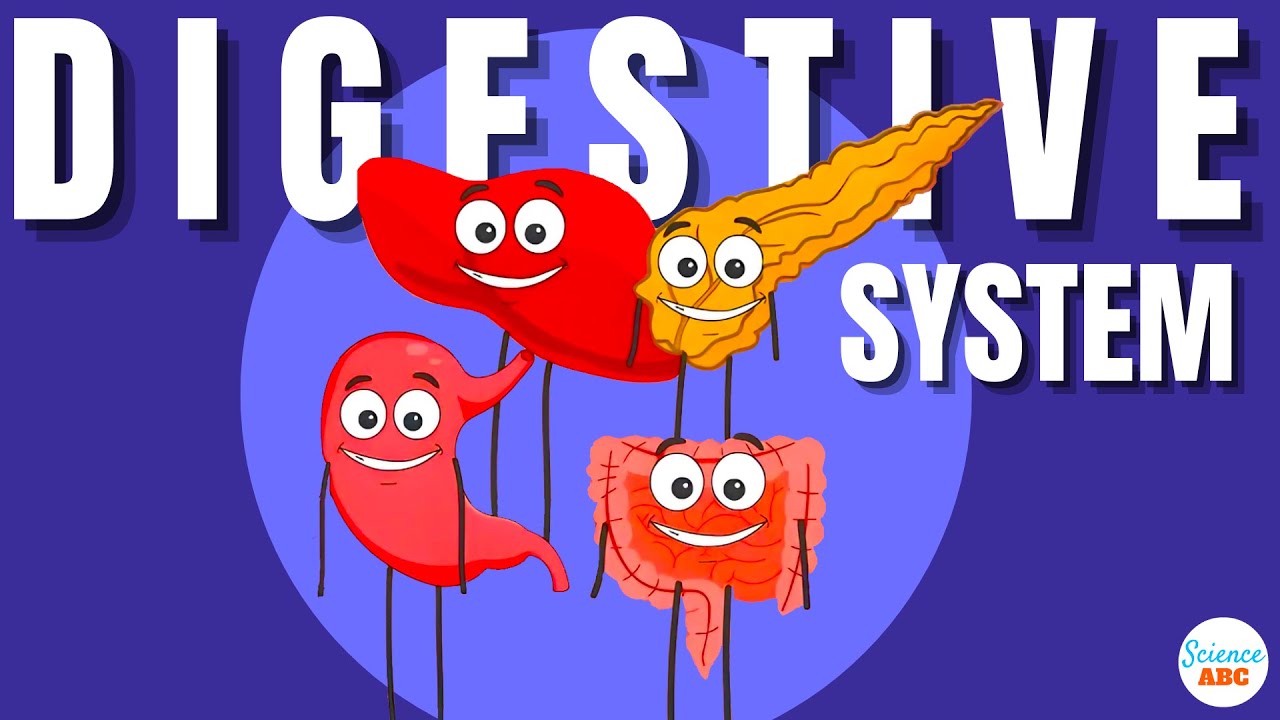NUTRITION IN HUMAN BEINGS
Summary
TLDRThe human digestive system involves a series of specialized organs responsible for breaking down food and absorbing nutrients. It starts with ingestion through the mouth, where food is chewed and mixed with saliva. The food then travels down the esophagus into the stomach, where gastric juices begin digestion. In the small intestine, enzymes from the pancreas, liver, and intestines further break down carbohydrates, proteins, and fats. Nutrients are absorbed through villi in the intestinal walls. The remaining waste moves into the large intestine, where water is absorbed, and the final waste is expelled through the anus.
Takeaways
- 😀 Digestion in humans involves the digestive system, which includes the elementary canal and digestive glands.
- 😀 The process of digestion begins with ingestion, where food is taken into the mouth.
- 😀 The food is chewed into smaller particles by teeth and the tongue, a process known as chewing.
- 😀 Saliva, secreted by salivary glands, helps form a soft bolus and contains amylase to break down starches into sugars.
- 😀 After chewing, the food moves down the esophagus to the stomach via peristalsis, a muscle-driven movement.
- 😀 The stomach, a large muscular organ, mixes food with digestive juices, including hydrochloric acid (HCl), mucus, and pepsin.
- 😀 HCl creates an acidic environment that aids the action of pepsin, which helps digest proteins.
- 😀 The food then enters the small intestine, where most digestion and nutrient absorption take place.
- 😀 The liver secretes bile, which emulsifies fats, and the pancreas secretes enzymes like trypsin and lipase to break down proteins and fats.
- 😀 The walls of the small intestine contain villi, which increase the surface area for nutrient absorption into the bloodstream.
- 😀 The absorbed nutrients are used by the body for energy and tissue repair, while unabsorbed food moves to the large intestine.
- 😀 In the large intestine, water is absorbed from the remaining food, and the waste is turned into feces, which is expelled through the anus.
Q & A
What is the process of nutrition in human beings called?
-The process of nutrition in human beings is called digestion.
What does the human digestive system include?
-The human digestive system includes the elementary canal and digestive glands.
What is the first part of the elementary canal?
-The first part of the elementary canal is the mouth.
What is the term used for the taking of food through the mouth?
-The term used for the taking of food through the mouth is ingestion.
What role do the teeth and tongue play in digestion?
-The teeth crush food into small particles, while the muscular tongue helps in mixing and moving the food during the process of chewing.
What is the function of saliva in the mouth?
-Saliva is secreted by the salivary glands into the buccal cavity and helps in forming a soft bolus. It contains the enzyme amylase, which breaks down starch into sugar.
What is peristalsis, and where does it occur?
-Peristalsis is the rhythmic muscular movement that pushes food forward through the digestive tract. It occurs in the esophagus and other parts of the digestive canal.
What happens in the stomach during digestion?
-In the stomach, food mixes with digestive juices and enzymes like pepsin. The gastric glands secrete hydrochloric acid (HCl), which creates an acidic environment to help pepsin break down proteins.
How is food digested in the small intestine?
-In the small intestine, bile from the liver breaks down fats into smaller globules, increasing enzyme efficiency. Pancreatic enzymes like trypsin and lipase further digest proteins and fats, and intestinal juices complete the digestion of food.
What is the role of villi in the small intestine?
-The villi in the small intestine increase the surface area for absorption. They are rich in blood vessels that transport absorbed nutrients to cells throughout the body.
What happens in the large intestine?
-In the large intestine, water is absorbed from the undigested food. The remaining material, called feces, is eventually eliminated from the body through the anus.
What is the function of the anal sphincter?
-The anal sphincter regulates the exit of feces from the body, controlling when it is released through the anus.
Outlines

This section is available to paid users only. Please upgrade to access this part.
Upgrade NowMindmap

This section is available to paid users only. Please upgrade to access this part.
Upgrade NowKeywords

This section is available to paid users only. Please upgrade to access this part.
Upgrade NowHighlights

This section is available to paid users only. Please upgrade to access this part.
Upgrade NowTranscripts

This section is available to paid users only. Please upgrade to access this part.
Upgrade NowBrowse More Related Video

Sistem Pencernaan: Organ dan Kelenjar Pencernaan || Cara Cepat Hafal Enzim Pencernaan

Die Verdauung des Menschen (Animation)

Once Upon a Time... Life - The digestion - Hello Maestro

Human Digestive System - How it works? | Its parts and functions

The Digestive Process - University of Michigan Health System

Digestive System: Ingestion to Egestion Explained in Simple Words
5.0 / 5 (0 votes)